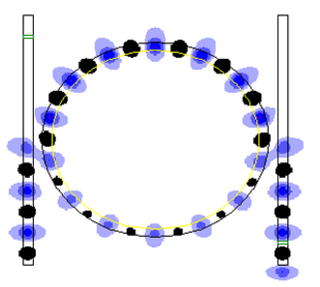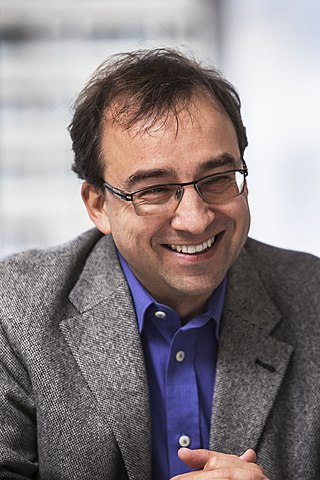Related Research Articles

A laser is a device that emits light through a process of optical amplification based on the stimulated emission of electromagnetic radiation. The word laser is an anacronym that originated as an acronym for light amplification by stimulated emission of radiation. The first laser was built in 1960 by Theodore Maiman at Hughes Research Laboratories, based on theoretical work by Charles H. Townes and Arthur Leonard Schawlow.
Q-switching, sometimes known as giant pulse formation or Q-spoiling, is a technique by which a laser can be made to produce a pulsed output beam. The technique allows the production of light pulses with extremely high (gigawatt) peak power, much higher than would be produced by the same laser if it were operating in a continuous wave mode. Compared to modelocking, another technique for pulse generation with lasers, Q-switching leads to much lower pulse repetition rates, much higher pulse energies, and much longer pulse durations. The two techniques are sometimes applied together.
Optical tweezers are scientific instruments that use a highly focused laser beam to hold and move microscopic and sub-microscopic objects like atoms, nanoparticles and droplets, in a manner similar to tweezers. If the object is held in air or vacuum without additional support, it can be called optical levitation.

A photonic crystal is an optical nanostructure in which the refractive index changes periodically. This affects the propagation of light in the same way that the structure of natural crystals gives rise to X-ray diffraction and that the atomic lattices of semiconductors affect their conductivity of electrons. Photonic crystals occur in nature in the form of structural coloration and animal reflectors, and, as artificially produced, promise to be useful in a range of applications.

An optical cavity, resonating cavity or optical resonator is an arrangement of mirrors or other optical elements that forms a cavity resonator for light waves. Optical cavities are a major component of lasers, surrounding the gain medium and providing feedback of the laser light. They are also used in optical parametric oscillators and some interferometers. Light confined in the cavity reflects multiple times, producing modes with certain resonance frequencies. Modes can be decomposed into longitudinal modes that differ only in frequency and transverse modes that have different intensity patterns across the cross-section of the beam. Many types of optical cavity produce standing wave modes.

The Pockels effect or Pockels electro-optic effect, also known as the linear electro-optic effect, is named after Friedrich Carl Alwin Pockels who studied the effect in 1893. The Pockels effect is a directionally dependent linear variation in the refractive index of an optical medium that occurs in response to the application of an electric field. The non-linear counterpart, the Kerr effect, causes changes in the refractive index at a rate proportional to the square of the applied electric field. In optical media, the Pockels effect causes changes in birefringence that vary in proportion to the strength of the applied electric field. The Pockels effect occurs in crystals that lack inversion symmetry, such as KH2PO4 (KDP), KD2PO4 (KD*P or DKDP), lithium niobate (LiNbO3), beta-barium borate (BBO), and in other non-centrosymmetric media such as electric-field poled polymers or glasses. The Pockels effect has been elucidated through extensive study of electro-optic properties in materials like KDP.

An optical ring resonator is a set of waveguides in which at least one is a closed loop coupled to some sort of light input and output. The concepts behind optical ring resonators are the same as those behind whispering galleries except that they use light and obey the properties behind constructive interference and total internal reflection. When light of the resonant wavelength is passed through the loop from the input waveguide, the light builds up in intensity over multiple round-trips owing to constructive interference and is output to the output bus waveguide which serves as a detector waveguide. Because only a select few wavelengths will be at resonance within the loop, the optical ring resonator functions as a filter. Additionally, as implied earlier, two or more ring waveguides can be coupled to each other to form an add/drop optical filter.

An optical microcavity or microresonator is a structure formed by reflecting faces on the two sides of a spacer layer or optical medium, or by wrapping a waveguide in a circular fashion to form a ring. The former type is a standing wave cavity, and the latter is a traveling wave cavity. The name microcavity stems from the fact that it is often only a few micrometers thick, the spacer layer sometimes even in the nanometer range. As with common lasers, this forms an optical cavity or optical resonator, allowing a standing wave to form inside the spacer layer or a traveling wave that goes around in the ring.
Quantum networks form an important element of quantum computing and quantum communication systems. Quantum networks facilitate the transmission of information in the form of quantum bits, also called qubits, between physically separated quantum processors. A quantum processor is a small quantum computer being able to perform quantum logic gates on a certain number of qubits. Quantum networks work in a similar way to classical networks. The main difference is that quantum networking, like quantum computing, is better at solving certain problems, such as modeling quantum systems.
Optical computing or photonic computing uses light waves produced by lasers or incoherent sources for data processing, data storage or data communication for computing. For decades, photons have shown promise to enable a higher bandwidth than the electrons used in conventional computers.
Silicon photonics is the study and application of photonic systems which use silicon as an optical medium. The silicon is usually patterned with sub-micrometre precision, into microphotonic components. These operate in the infrared, most commonly at the 1.55 micrometre wavelength used by most fiber optic telecommunication systems. The silicon typically lies on top of a layer of silica in what is known as silicon on insulator (SOI).
Anthony E. Siegman was an electrical engineer and educator at Stanford University who investigated and taught about masers and lasers. Known to almost all as Tony Siegman, he was president of the Optical Society of America [now Optica (society)] in 1999 and was awarded the Esther Hoffman Beller Medal in 2009.

An atomic clock is a clock that measures time by monitoring the resonant frequency of atoms. It is based on atoms having different energy levels. Electron states in an atom are associated with different energy levels, and in transitions between such states they interact with a very specific frequency of electromagnetic radiation. This phenomenon serves as the basis for the International System of Units' (SI) definition of a second:
The second, symbol s, is the SI unit of time. It is defined by taking the fixed numerical value of the caesium frequency, , the unperturbed ground-state hyperfine transition frequency of the caesium 133 atom, to be 9192631770 when expressed in the unit Hz, which is equal to s−1.
An optical transistor, also known as an optical switch or a light valve, is a device that switches or amplifies optical signals. Light occurring on an optical transistor's input changes the intensity of light emitted from the transistor's output while output power is supplied by an additional optical source. Since the input signal intensity may be weaker than that of the source, an optical transistor amplifies the optical signal. The device is the optical analog of the electronic transistor that forms the basis of modern electronic devices. Optical transistors provide a means to control light using only light and has applications in optical computing and fiber-optic communication networks. Such technology has the potential to exceed the speed of electronics, while conserving more power. The fastest demonstrated all-optical switching signal is 900 attoseconds, which paves the way to develop ultrafast optical transistors.
A plasmonic metamaterial is a metamaterial that uses surface plasmons to achieve optical properties not seen in nature. Plasmons are produced from the interaction of light with metal-dielectric materials. Under specific conditions, the incident light couples with the surface plasmons to create self-sustaining, propagating electromagnetic waves known as surface plasmon polaritons (SPPs). Once launched, the SPPs ripple along the metal-dielectric interface. Compared with the incident light, the SPPs can be much shorter in wavelength.
Potential graphene applications include lightweight, thin, and flexible electric/photonics circuits, solar cells, and various medical, chemical and industrial processes enhanced or enabled by the use of new graphene materials.
A nanophotonic resonator or nanocavity is an optical cavity which is on the order of tens to hundreds of nanometers in size. Optical cavities are a major component of all lasers, they are responsible for providing amplification of a light source via positive feedback, a process known as amplified spontaneous emission or ASE. Nanophotonic resonators offer inherently higher light energy confinement than ordinary cavities, which means stronger light-material interactions, and therefore lower lasing threshold provided the quality factor of the resonator is high. Nanophotonic resonators can be made with photonic crystals, silicon, diamond, or metals such as gold.

Luigi Lugiato is an Italian physicist and professor emeritus at University of Insubria (Varese/Como). He is best known for his work in theoretical nonlinear and quantum optics, and especially for the Lugiato–Lefever equation (LLE,). He has authored more than 340 scientific articles, and the textbook Nonlinear Dynamical Systems. His work has been theoretical but has stimulated a large number of important experiments in the world. It is also characterized by the fact of combining the classical and quantum aspects of optical systems.

Juerg Leuthold is a full professor at ETH Zurich, Switzerland.
Sasikanth Manipatruni is an American engineer and inventor in the fields of Computer engineering, Integrated circuit technology, Materials Engineering and semiconductor device fabrication. Manipatruni contributed to developments in silicon photonics, spintronics and quantum materials.
References
- ↑ Jin, C.-Y.; Johne, R.; Swinkels, M.; Hoang, T.; Midolo, L.; van Veldhoven, P.J.; Fiore, A. (Nov 2014). "Ultrafast non-local control of spontaneous emission". Nature Nanotechnology. 9 (11): 886–890. arXiv: 1311.2233 . Bibcode:2014NatNa...9..886J. doi:10.1038/nnano.2014.190. PMID 25218324. S2CID 28467862.
- ↑ Sattler, T.; Peinke, E.; Bleuse, J.; Claudon, J.; Vos, W.L.; Gérard, J.M. (July 2017). "Cavity switching: A novel resource for solid-state quantum optics". 2017 19th International Conference on Transparent Optical Networks (ICTON). Proceedings of the 19th International Conference on Transparent Optical Networks (ICTON). p. 17154854. doi:10.1109/ICTON.2017.8025177. ISBN 978-1-5386-0859-3. S2CID 29987371.